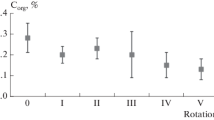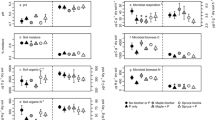Summary
Protozoa (testate amoebae, ciliates), small metazoa (rotifers, nematodes), and soil enzymes (catalase, cellulase) were investigated in a reafforested fertilized site at the alpine timberline. Side-dressings of mineral and organic fertilizers were applied alone (90 g NPK; 90, 180, 300, and 450 g dried bacterial biomass per spruce seedling) and in combination with magnesite (90 g NPK+300 g Mg; 90, 180, and 300 g bacterial biomass + 300 g Mg each; 30 g dried fungal biomass + 270 g Mg). One-third of each quantity was applied in 1986, and two-thirds in 1988. None of the treatments caused a significant decrease in the biological parameters investigated in comparison with untreated controls. The soil life was more or less stimulated depending on the amount of organic material contained in the fertilizers and the quantity; 180–270 g organic material per seedling proved to be the most effective. Dried bacterial biomass increased the pH by about 0.5 units, catalase activity by about 70%, and the number of ciliates and nematodes by 150–400%. The ciliate biomass and the number of ciliate species were likewise increased. The organomineral fertilizers increased pH by up to two units and also stimulated the soil life, but where the organic content was less than 180 g per seedling, efficiency decreased markedly. The least biological activity was observed in the control soil and in soil fertilized with NPK. Testaceans, rotifers, and cellulolytic activities were only slightly (insignificantly) affected by the treatments. A pooled evaluation of the data (organic versus organomineral versus mineral treatments) and community analyses showed that the organic fertilizer caused a more pronounced increase in the soil life and greater changes in community structure than the mineral combinations. Two years after application of the fertilizers, the differences between the treatments and the unfertilized controls had diminished.
Similar content being viewed by others
References
Beck L (1989) Lebensraum Buchenwaldboden. 1. Bodenfauna und Streuabbau — eine Übersicht. Verh Ges Oekol (Goettingen 1987) 17:47–54
Beck T (1971) Die Messung der Katalaseaktivität von Böden. Z Pflanzenernaehr Bodenkd 130:68–81
Berger H, Foissner W, Adam H (1986) Field experiments on the effects of fertilizers and lime on the soil microfauna of an alpine pasture. Pedobiologia 29:261–272
Bray JR, Curtis JT (1957) An ordination of the upland forest community in southern Wisconsin. Ecol Monogr 27:325–349
Chardez D, Delecour F, Weissen F (1972) Évolution des populations thécamoebiennes de sols forestiers sous l'influence de fumures artificielles. Revue Ecol Biol Sol 9:185–196
Foissner W (1981) Die Gemeinschaftsstruktur der Ciliatenzönose in alpinen Böden (Hohe Tauern, Österreich) und Grundlagen für eine Synökologie der terricolen Ciliaten (Protozoa, Ciliophora). Veroeff Oesterr MaB-Programms 4:7–52
Foissner W (1985) Protozoologische Untersuchungen an Almböden im Gasteiner Tal (Zentralalpen, Österreich). III. Struktur und Dynamik der Testaceen-und Ciliatentaxozönose. Veroeff Oesterr MaB-Programms 9:65–95
Foissner W (1987a) The micro-edaphon in ecofarmed and conventionally farmed dryland cornfields near Vienna (Austria). Biol Fertil Soils 3:45–49
Foissner W (1987b) Soil protozoa: Fundamental problems, ecological significance, adaptations in ciliates and testaceans, bioindicators, and guide to the literature. Prog Protistol 2:69–212
Foissner W, Franz H, Adam H (1982) Terrestrische Protozoen als Bioindikatoren im Boden einer planierten Ski-Piste. Pedobiologia 24:45–56
Glatzel G, Fuchs J (1986) Zur Anwendung organischer Spezialdüngemittel bei schwierigen Aufforstungen. Allg Forst Z 9/10:1–4
Glatzel G, Haselwandter K, Katzensteiner K, Sterba H, Weissbacher J (1991) The use of organic and mineral fertilizers in reforestation and in revitalization of declining protective forests in the alps. Water Air Soil Pollut (in press)
Hofmann J (1979) Enzym-Aktivitätsmessungen im Raum Obergurgl: Cellulase-Xylanase-Pektinaseaktivitätsmessungen und mikrobielle Biomassebestimmung. PhD dissertation, University of Innsbruck
Insam H, Haselwandter K (1985) Die Wirkung verschiedener Begründungsmaßnahmen auf die mikrobielle Biomasse im Boden planierter Skipisten oberhalb der Waldgrenze. Z Vegetationst 8:23–28
Jaccard P (1902) Lois de distribution florale dans la zone alpine. Bull Soc Vaudoise Sci Nat 38:69–130
Kilian W, Glatzel G (1989) Waldbodensanierung in Österreich. Österr Forstz 3:43–44
Köck L, Holaus K (1981) Erste Ergebnisse zur Verbesserung des Pflanzenwuchses auf Schipisten mit Pilzmycel. Z Vegetationst 5:70–72
Lüftenegger G, Foissner W, Adam H (1985) r-and K-selection in soil ciliates: A field and experimental approach. Oecologia 66:574–579
Lüftenegger G, Foissner W, Adam H (1986) Der Einfluss organischer und mineralischer Dünger auf die Bodenfauna einer planierten, begrünten Schipiste oberhalb der Waldgrenze. Z Vegetationist 9:149–153
Lüftenegger G, Petz W, Foissner W, Adam H (1988) The efficiency of a direct counting method in estimating the numbers of microscopic soil organisms. Pedobiologia 31:95–101
Moder K (1990) Test analysis with homogenized groups at the beginning of an experiment. Bodenkultur 41:1–6
Morisita M (1959) Measuring of interspecific association and similarity between communities. Mem Fac Sci Kyushu Univ, Ser E Bio 3:65–80
Mulla DJ, Bhatti AU, Kunkel R (1990) Methods for removing spatial variability from field research trials. Adv Soil Sci 13:201–213
Petz W, Foissner W (1988) Spatial separation of terrestrial ciliates and testaceans (Protozoa): a contribution to soil ciliatostasis. Acta Protozool 27:249–258
Sachs L (1984) Angewandte Statistik, 6th edn. Springer, Berlin Heidelberg New York
Scheffer F, Schachtschabel P (1982) Lehrbuch der Bodenkunde, 11th edn. Enke, Stuttgart
Schuster WH, Lochow Jv (1979) Anlage und Auswertung von Feldversuchen, 2nd edn. DLG, Frankfurt
Steel RGD, Torrie JH (1980) Principles and procedures of statistics: A biometrical approach, 2nd edn. McGraw-Hill, New York
Tranquillini W (1979) Physiological ecology of the alpine timberline. Tree existence at high altitudes with special reference to the European alps. Ecol Stud 31:1–137
Wodarz D, Aescht E, Foissner W (1992) The Soil Biological Index (SBI): a biased relative measure for disturbed terrestrial biocoenoses. Biol Fertil Soils (submitted)
Author information
Authors and Affiliations
Rights and permissions
About this article
Cite this article
Aescht, E., Foissner, W. Effects of mineral and organic fertilizers on the microfauna in a high-altitude reafforestation trial. Biol Fert Soils 13, 17–24 (1992). https://doi.org/10.1007/BF00337232
Received:
Issue Date:
DOI: https://doi.org/10.1007/BF00337232




